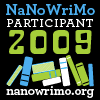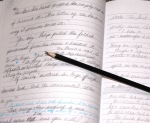 Well, I’ve done it. I’ve joined the over 100,000 NaNoWriMo participants world wide who plan to write a 50,000 word novel in the month of November. Chris Baty, who began NaNoWriMo 10 years ago with a small group of friends, describes the next 30 days like this: “Because of the limited writing window, the ONLY thing that matters in NaNoWriMo is output. It’s all about quantity, not quality. The kamikaze approach forces you to lower your expectations, take risks, and write on the fly.”
Well, I’ve done it. I’ve joined the over 100,000 NaNoWriMo participants world wide who plan to write a 50,000 word novel in the month of November. Chris Baty, who began NaNoWriMo 10 years ago with a small group of friends, describes the next 30 days like this: “Because of the limited writing window, the ONLY thing that matters in NaNoWriMo is output. It’s all about quantity, not quality. The kamikaze approach forces you to lower your expectations, take risks, and write on the fly.”
His last statement summarizes what is, for me, the greatest appeal of the project. I earn part of my living by writing, so what I create is calculated to meet my expectations of professionalism. I strive for my copy to be clean of errors and excess verbiage and to serve well the demands of my client or editor. While my NaNoWriMo file is open next month, my expectations are going on holiday. I plan to enjoy some freedom, take risks, surprise myself and my characters–and have fun.
It’s been a while since writing was just fun. I can’t wait to put my built-in, bossy editor on hold and to enjoy the words appearing on my screen, whether they are the perfect words or not at that moment. At least I’ll be writing something just for me.
I’m sure that my output won’t be anywhere near 50,000 words at the end of the month, and I’m not worried about it. What I have done is set aside writing time every day, and that commitment alone means that I am honoring that part of myself that is “the writer.” All the other hats I wear get my time and attention, but my writer hat gets left on the shelf more than the others. And I miss it.
For the month of November, I’ll be wearing my writer hat every day, and on November 30th, I’ll have more words than I started with and a month of remembering what it is like to be a writer. And maybe that means, for the future, that my writer hat will come off the shelf more often. I’d like that.
 This is the times of year when the days get shorter but my to-do list doesn’t. I would love to take a step back from things and just catch my breath, but I know that’s not going to happen right now. I force myself to take a simpler approach to things. A few more meals get cooked in the slow cooker. I use my headphones and MP3 player more often to keep something joyful in my ears—and the noise around me silenced.
This is the times of year when the days get shorter but my to-do list doesn’t. I would love to take a step back from things and just catch my breath, but I know that’s not going to happen right now. I force myself to take a simpler approach to things. A few more meals get cooked in the slow cooker. I use my headphones and MP3 player more often to keep something joyful in my ears—and the noise around me silenced. 31-35 Just one prompt today and that’s for NaNoWriMo writers like me who don’t have a plot yet.
31-35 Just one prompt today and that’s for NaNoWriMo writers like me who don’t have a plot yet.